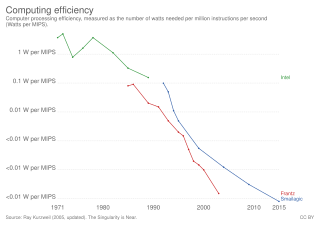Related Research Articles

Instructions per second (IPS) is a measure of a computer's processor speed. For complex instruction set computers (CISCs), different instructions take different amounts of time, so the value measured depends on the instruction mix; even for comparing processors in the same family the IPS measurement can be problematic. Many reported IPS values have represented "peak" execution rates on artificial instruction sequences with few branches and no cache contention, whereas realistic workloads typically lead to significantly lower IPS values. Memory hierarchy also greatly affects processor performance, an issue barely considered in IPS calculations. Because of these problems, synthetic benchmarks such as Dhrystone are now generally used to estimate computer performance in commonly used applications, and raw IPS has fallen into disuse.

A supercomputer is a computer with a high level of performance as compared to a general-purpose computer. The performance of a supercomputer is commonly measured in floating-point operations per second (FLOPS) instead of million instructions per second (MIPS). Since 2017, there have existed supercomputers which can perform over 1017 FLOPS (a hundred quadrillion FLOPS, 100 petaFLOPS or 100 PFLOPS).

In computing, floating point operations per second is a measure of computer performance, useful in fields of scientific computations that require floating-point calculations. For such cases, it is a more accurate measure than measuring instructions per second.

The IBM Information Management System (IMS) is a joint hierarchical database and information management system that supports transaction processing.

POWER7 is a family of superscalar multi-core microprocessors based on the Power ISA 2.06 instruction set architecture released in 2010 that succeeded the POWER6 and POWER6+. POWER7 was developed by IBM at several sites including IBM's Rochester, MN; Austin, TX; Essex Junction, VT; T. J. Watson Research Center, NY; Bromont, QC and IBM Deutschland Research & Development GmbH, Böblingen, Germany laboratories. IBM announced servers based on POWER7 on 8 February 2010.

In computing, a benchmark is the act of running a computer program, a set of programs, or other operations, in order to assess the relative performance of an object, normally by running a number of standard tests and trials against it.

Scalable POWERparallel (SP) is a series of supercomputers from IBM. SP systems were part of the IBM RISC System/6000 (RS/6000) family, and were also called the RS/6000 SP. The first model, the SP1, was introduced in February 1993, and new models were introduced throughout the 1990s until the RS/6000 was succeeded by eServer pSeries in October 2000. The SP is a distributed memory system, consisting of multiple RS/6000-based nodes interconnected by an IBM-proprietary switch called the High Performance Switch (HPS). The nodes are clustered using software called PSSP, which is mainly written in Perl.
Xmark93 is a standardized benchmarking tool for measuring the performance of computer systems running the X Window System. It was developed by the SPEC XPC group in 1993.
EEMBC, the Embedded Microprocessor Benchmark Consortium, is a non-profit, member-funded organization formed in 1997, focused on the creation of standard benchmarks for the hardware and software used in embedded systems. The goal of its members is to make EEMBC benchmarks an industry standard for evaluating the capabilities of embedded processors, compilers, and the associated embedded system implementations, according to objective, clearly defined, application-based criteria. EEMBC members may contribute to the development of benchmarks, vote at various stages before public distribution, and accelerate testing of their platforms through early access to benchmarks and associated specifications.
The Commercial Processing Workload (CPW) is a simplified variant of the industry-wide TPC-C benchmarking standard originally developed by IBM to compare the performance of their various AS/400 server offerings.

The TOP500 project ranks and details the 500 most powerful non-distributed computer systems in the world. The project was started in 1993 and publishes an updated list of the supercomputers twice a year. The first of these updates always coincides with the International Supercomputing Conference in June, and the second is presented at the ACM/IEEE Supercomputing Conference in November. The project aims to provide a reliable basis for tracking and detecting trends in high-performance computing and bases rankings on HPL, a portable implementation of the high-performance LINPACK benchmark written in Fortran for distributed-memory computers.
In computing, performance per watt is a measure of the energy efficiency of a particular computer architecture or computer hardware. Literally, it measures the rate of computation that can be delivered by a computer for every watt of power consumed. This rate is typically measured by performance on the LINPACK benchmark when trying to compare between computing systems: an example using this is the Green500 list of supercomputers. Performance per watt has been suggested to be a more sustainable measure of computing than Moore’s Law.
The SPARC T3 microprocessor is a multithreading, multi-core CPU produced by Oracle Corporation. Officially launched on 20 September 2010, it is a member of the SPARC family, and the successor to the UltraSPARC T2.
RPE2, or Relative server Performance Estimate 2, is a computer benchmark developed by Ideas International to compare the relative performance of servers built on x86, IA-64, and RISC processor architectures.

The K computer – named for the Japanese word/numeral "kei" (京), meaning 10 quadrillion (1016) – was a supercomputer manufactured by Fujitsu, installed at the Riken Advanced Institute for Computational Science campus in Kobe, Hyōgo Prefecture, Japan. The K computer was based on a distributed memory architecture with over 80,000 compute nodes. It was used for a variety of applications, including climate research, disaster prevention and medical research. The K computer's operating system was based on the Linux kernel, with additional drivers designed to make use of the computer's hardware.
perf is a performance analyzing tool in Linux, available from Linux kernel version 2.6.31 in 2009. Userspace controlling utility, named perf, is accessed from the command line and provides a number of subcommands; it is capable of statistical profiling of the entire system.
In computing, OProfile is a system-wide statistical profiling tool for Linux. John Levon wrote it in 2001 for Linux kernel version 2.4 after his M.Sc. project; it consists of a kernel module, a user-space daemon and several user-space tools.

IBM FlashSystem is an IBM Storage enterprise system that stores data on flash memory. Unlike storage systems that use standard solid-state drives, IBM FlashSystem products incorporate custom hardware based on technology from the 2012 IBM acquisition of Texas Memory Systems.
PerfKit Benchmarker is an open source benchmarking tool used to measure and compare cloud offerings. PerfKit Benchmarker is licensed under the Apache 2 license terms. PerfKit Benchmarker is a community effort involving over 500 participants including researchers, academic institutions and companies together with the originator, Google.

Fugaku(Japanese: 富岳) is a petascale supercomputer at the Riken Center for Computational Science in Kobe, Japan. It started development in 2014 as the successor to the K computer and made its debut in 2020. It is named after an alternative name for Mount Fuji.
References
- ↑ "It's All Relative". IBMSystems Magazine. Retrieved 2011-08-03.